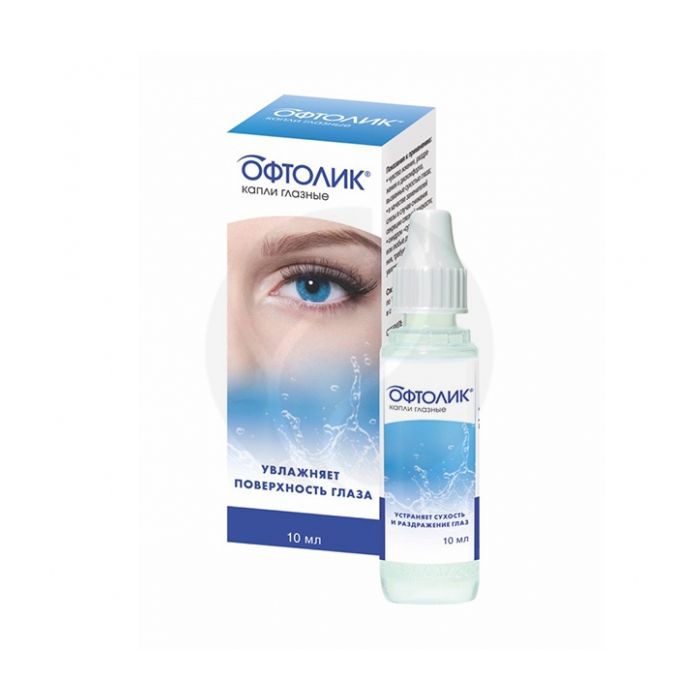Ophthalmic eye drops, 10ml
Expiration Date: 05/2027
Russian Pharmacy name:
Офтолик капли глазные, 10мл
A burning sensation, irritation, and discomfort caused by dry eye;
as a substitute for tears in case of a decrease in the secretion of tear fluid;
dry eye syndrome;
other conditions requiring softening and / or moisturizing of the cornea.
Assign 1-2 drops 3-4 times / day in both eyes, depending on the severity of symptoms.
Rules for using the drug
Wash hands before using the drug. Shake the bottle and remove the cap. Make sure that the tip of the pipette does not touch the skin or surface of the eye to prevent infection of the mucous membrane. Tilt your head back, pull the lower eyelid down, turn the bottle over and instill the required number of drops into the conjunctival sac. After use, the bottle should be tightly closed with a cap.
Eye drops in the form of a transparent, colorless or slightly yellowish solution.
1 ml
povidone 6 mg
polyvinyl alcohol 14 mg
Excipients: benzalkonium chloride, disodium edetate, sodium chloride, water d / i.
Hypersensitivity to the components of the drug.
pharmachologic effect
Keratoprotector. The drug has a protective effect on the cornea of ??the eye with decreased secretion of tear fluid or increased evaporation of the tear film. Polyvinyl alcohol and povidone have lubricant properties that reduce eye irritation and redness. By covering the surface of the eye, these substances reduce surface tension and prevent tears from tearing. Polyvinyl alcohol has properties similar to mucin produced by the conjunctival glands. It helps soften and lubricate (moisturize) the surface of the eye, increases the stability of the tear film.
Pharmacokinetics
Systemic absorption of the drug from the surface of the eye is minimal: after instillation, 2 drops. Ophthalmic in each eye, the concentration of the active substances of the drug in the plasma after 4 hours remains below the possible limit of quantitative determination (10 ng / ml).
Side effect
Possibly: allergic reactions to the components of the drug.
Application during pregnancy and lactation
There is no sufficient experience in the use of the drug during pregnancy and lactation.
The use of the drug during pregnancy and lactation (breastfeeding) is possible only if the intended benefit to the mother outweighs the potential risk to the fetus.
special instructions
Do not use the drug if the color of the solution has changed or it becomes cloudy. In order to prevent infection of the mucous membrane of the eye, it is necessary to ensure that the tip of the pipette does not touch the skin, the surface of the eye or other surfaces during the application of the drug. The patient should stop using the drug and consult a doctor if: when using drops, the pain increases; vision deteriorates; symptoms persist for more than 72 hours; redness and irritation of the eyes persists. The drug contains benzalkonium chloride, so contact lenses should not be worn within 20 minutes after applying the drops.
Overdose
Data on drug overdose are not provided.
Drug interactions
Polyvinyl alcohol undergoes an esterification reaction characteristic of compounds with secondary hydroxy groups. It breaks down in strong acids and softens or dissolves in weak acids and alkalis. In high concentrations, polyvinyl alcohol is incompatible with inorganic salts, especially phosphates and sulfates. Sludge formation of 5% polyvinyl alcohol can be caused by reaction with phosphates. The formation of a gel from a solution of polyvinyl alcohol can occur in the presence of borax. Povidone solution is compatible with many inorganic salts, natural and synthetic resins and other substances. Interacts in solution with sulfathiazole, sodium salicylate, salicylic acid, phenobarbital, tannin and other substances. The effectiveness of some preservatives (for example,thiomersal) may decrease due to the formation of complexes with povidone
'
